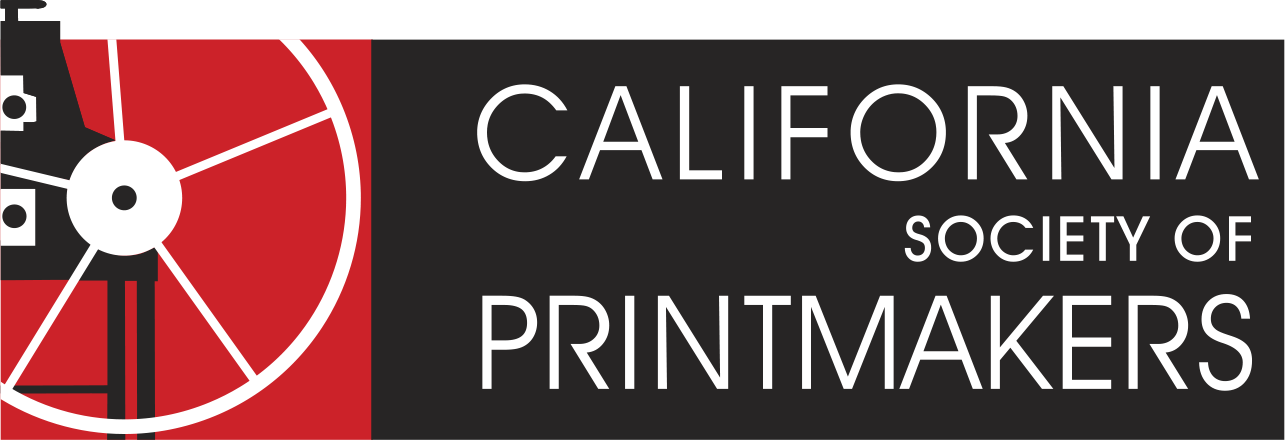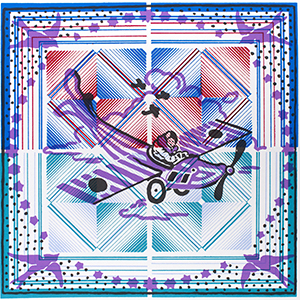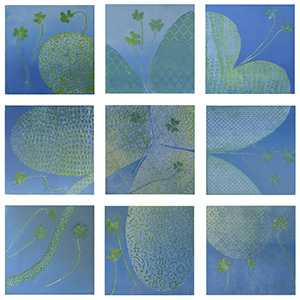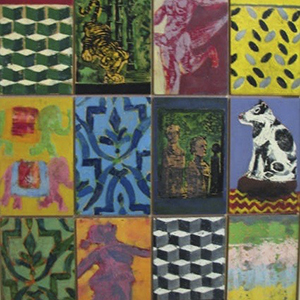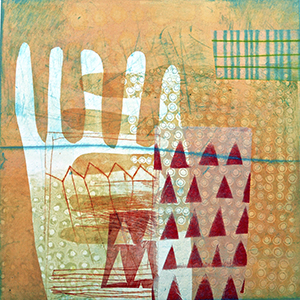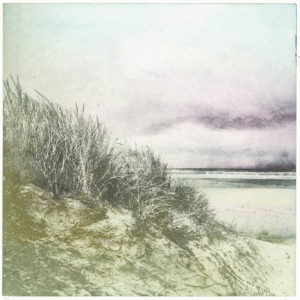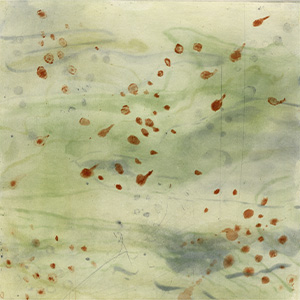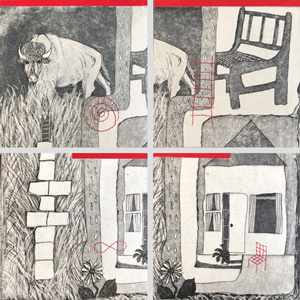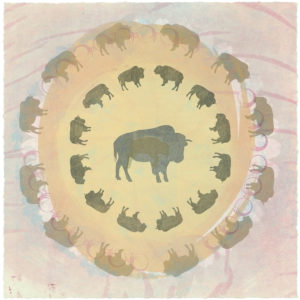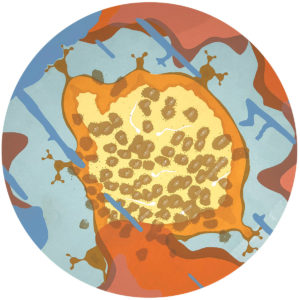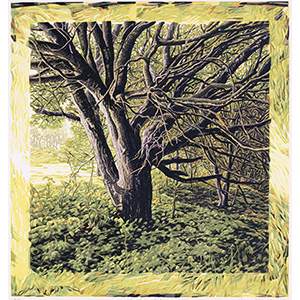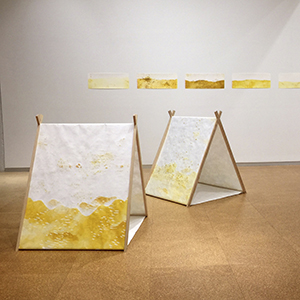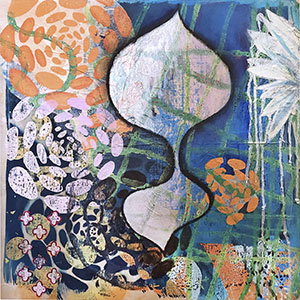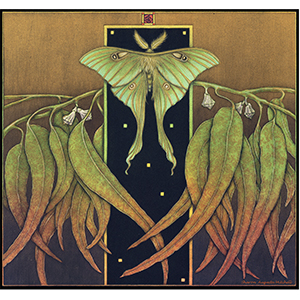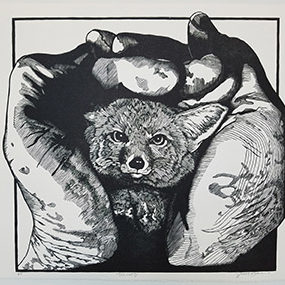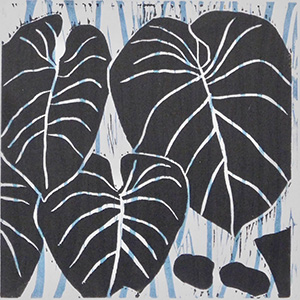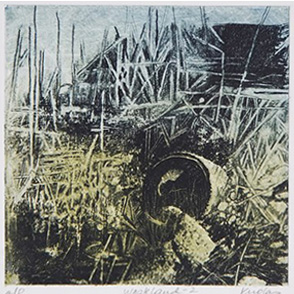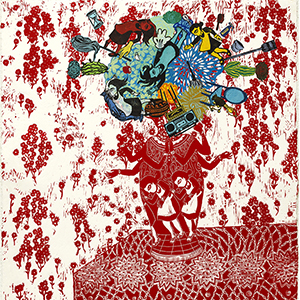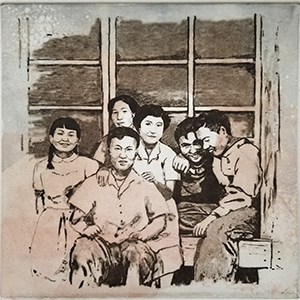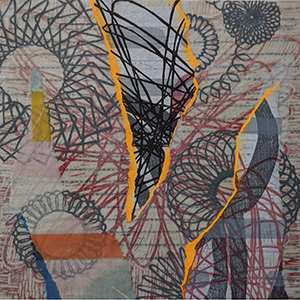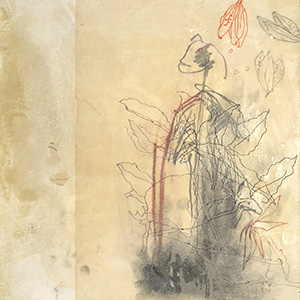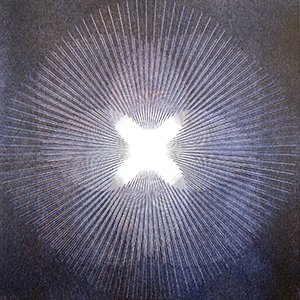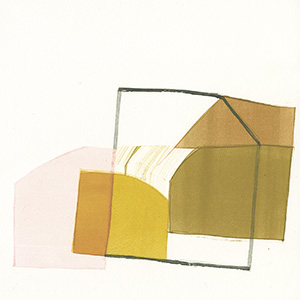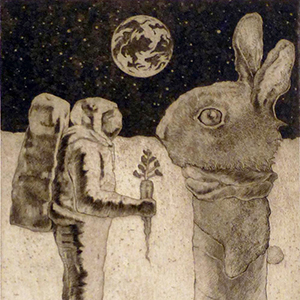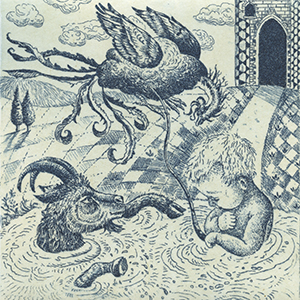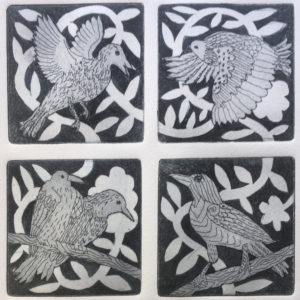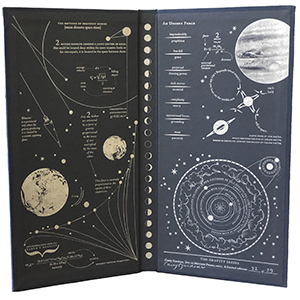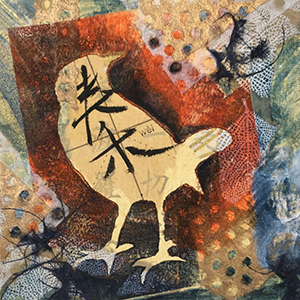glossary
This glossary is from the California Society of Printmakers’ Centennial Book.
À la Poupée
French: with the doll
An intaglio method in which cotton dabbers or felt pads are used to hand-apply several different colors to a single plate. The technique allows the artist to use multiple colors with one run of the plate through the press. Also known as the oneplate method.
Acrylic Monotype
An image painted on a plate with acrylic paint and a gel medium base, or formulated to be slow drying, then transferred to paper with (often hand) pressure. See also Monotype.
Aquapasto
With watercolor and gouache or water-soluble crayon for a monotype.
Aquatint
An intaglio process in which rosin powder is evenly sifted over and etched into a copper plate using a stop-out varnish in various places to protect the plate during successive acid baths. The technique creates an even tooth (texture) on the surface of the plate that catches the ink, allowing the artist to produce a controlled range of tonal areas in the image from dark to light. Often combined with other intaglio methods such as etching and drypoint.
Aquatint Etching
An image created exclusively by the aquatint technique. See previous entry.
Archival Pigment Print
See Digital Print.
Artist’s ProofA/P
See Proof.
Baren/Japanese Baren
A round, hand-held pad used to burnish or apply pressure to the back of relief prints. Traditionally made with an ategawa (circular stiff backing piece), a shin (coiled pad of twisted fiber), and a barengawa (cover) made from a takenokawa (bamboo sheath) that is tightly twisted and tied around the back. Modern barens can be made with plastics, ball bearings, and other materials.
Bleed Print
A printed image that extends to the edges of the sheet. To achieve a bleed print, the printer must print a larger image than the paper, after which the printed deckle is preserved or the paper is cut to size.
Blind Embossment
See Embossment.
Block, Block Print
See Relief Print.
Bon à Tirer
French: good to print
The print a master printer uses as an exemplar for printing an edition. Also known as BAT.
Burin
An engraving tool with different-shaped tips, used for both wood and metal plates. Also known as a graver.
Caran d’Ache
A commercial brand of water-soluble pencils, crayons, pastels, and other drawing tools.
Chiaroscuro Woodcut
Italian: light-dark
A multi-block technique used to achieve gradual shifts in tone from light to dark; traditionally, a black key block that describes the complete image using thin black lines is printed over the tonal block(s). The technique originated in Germany around 1500. Italian chiaroscuro prints from that period used only tonal blocks, allowing the fi nished piece to resemble a wash drawing. In the modern era, the look of a chiaroscuro woodcut can be achieved with a reductive technique using one block. See also Reduction Print.
Chine Collé
French: glued lightweight Asian paper
An image printed on thin pieces of (often colored) delicate paper designed to embellish part of a larger print, or which underlies an entire print. The dampened tissue is placed on the inked plate, lightly treated with paste on its back, and adhered to the heavier sheet with one pass through the press.
Chromoxylography
A late 19th and early 20th century color printing technique using wood engraving and woodcut plates. The process, often used for color book illustration, employs separate blocks for printing primary colors that are layered or combined to create other colors. The blocks are often intricately carved to resemble hatching. When printed on top of each other, the hatched areas suggest a wide range of tints and colors. See also Wood engraving, Xylography.
Clay Monotype
A monotype technique made with a leather-hard, flat, clay plate and painted with kaolin (white clay) into which some form of pure pigment has been added. The print is made by placing dampened paper or another support on the clay, then rolling the back of the paper/support with a brayer or roller. Pigment from the clay substrate is lifted and embedded into the surface of the paper, resulting in a unique archival print. See also Monotype.
CNC
A Computer Numeric Control device used in manufacturing and printmaking in which a digital fi le is sent to a computercontrolled cutting device such as a CNC router, laser cutter, or water jet used for the production of matrices for lithography, intaglio, and relief printmaking, or other non-art-related items. The list of CNC devices is growing, as contemporary printmakers use embroidery machines, engraving machines, pencil plotters, vinyl cutters, and cutting plotters (among others) to create matrices and prints. See also Laser-Cut Woodcut.
Collagraph
A blending of “collage” and “graphic” to describe a print made from a plate with low-relief collage elements glued to its surface. Any thin, sturdy material such as cardboard, metal, linoleum, or plastic can serve as the plate; materials such as paper, cloth, or other found textures are adhered to it or may be built up on it with glues or acrylic medium. The plate can be inked and printed with intaglio or relief methods. Sometimes spelled collograph. See also Photocollagraphy.
Copper Plate
A flat plate made of polished copper used by artists for etching, engraving, and other intaglio printing techniques. Zinc is an alternative metal plate used for the same purposes.
Deckle Edge/Deckle
The irregular or rough edge naturally formed on handmade papers. Artificial deckles can also be found on machine-made papers.
Digital Print
Any print that is created from a digital file. Fine artists who use digital printing methods employing high-quality archival paper and lightfast pigment inks often call their works archival pigment prints. Artist-printmakers and commercial printers use the same materials and technology for different purposes. The artist-printmaker uses the computer and digital imaging software to create original images printed with the inks and paper described above. The same or similar digital printing systems are also used for commercial purposes, in some cases to make high-quality gicl.e reproductions of art created in other media. Giclée reproductions may also be called digital prints.
Drypoint
An intaglio technique in which lines are drawn or scratched directly into a metal plate with a sharp tool. The metal that is raised around the scratched incisions (the burr) is left on the plate, allowing the burr to catch and hold the applied ink. Variation in the depth of the mark determines how dark the line appears. Drypoint is recognizable by its soft, dark, velvety lines. Repeated printing wears the burr down and weakens the darker lines in the print.
Edition
The printed impressions made from a plate or plates signed and numbered by the artist. The numbered edition excludes various impressions or proofs made for other reasons, such as artist’s or trial proofs. See also Proof.
Embossment
An image or part of a design that is raised above the print surface, or seen as if in relief. The effect is produced by pressing soft or dampened paper into depressed areas of a plate so the paper holds the shape of the depression. If no ink is used in the process, the print is referred to as a blind embossment.
Engraving
An intaglio or relief technique of incising an image or design with gravers into a metal plate or the end grain of a block of wood. An engraved line may be thin at its beginning, swell at its center, and thin out again as the tool delicately enters, reaches greater depth, and leaves the metal or wood surface. Both metal and wood engravings are known for their sharp, precise lines, and for the skill and patience the technique requires. See also Wood Engraving.
Etching
An intaglio technique in which a metal plate is coated with an acid-resistant material or “ground.” The image is made by removing parts of the ground with varied tools to expose parts of the plate. The acid corrodes the exposed surfaces, creating depressed lines and textures that are later inked and printed. See also Hard Ground Etching; Intaglio.
Foil Monoprint Relief
An impression of an object or shape made from aluminum foil, modifi ed by the artist, then relief inked and run through a press. The print incorporates textures caused by the pressed foil. A unique method developed by Roy Ragle. Aluminum foil monoprint methods may also be used in combination with collagraph techniques.
Gampi
A thin Japanese paper made from natural bark, often used for chine collé.
Ghost
The second, lighter print made from the residual ink left on a monotype plate. See also Monotype.
Giclée
A digital print made with an inkjet printer using lightfast pigment inks on archival paper or canvas. The term is used to define high-quality printed reproductions of paintings, drawings, and prints. So named after the French gicleur, nozzle, or jet as in propelling spurts of ink. Contrast with digital printabove.
Graver
See Burin
Ground
An acid-resistant material such as wax or asphaltum thinly applied to an etching plate. A drawing is made through the ground with an etching needle, exposing the metal plate. When the plate is dipped in a strong acid, the drawing is bitten or etched into the metal. See also Hard Ground Etching; Soft Ground Etching; Spit Bite; White Ground Etching.
Gyotaku
A traditional Japanese fish printing or fish rubbing process. Soft paper is laid on top of the painted fish and printed.
Hanga/Moku Hanga
The Japanese phrase for woodblock printing (moku = wood, hanga = print). Often associated with the Japanese Ukiyo-e style (art of the floating world) that flourished in the Edo period, between the 1650s and 1850s. Early Japanese methods required a black key block that defined the design and served as a guide for the placement of all the colors. Separate blocks were carved for each color. For printing, the blocks were first coated with a thin layer of rice paste to delay drying of the colors. Printers used water-based colors delicately applied to the carved blocks with soft, wide brushes. Japanese Ukiyo-e woodcuts typically used traditional washi papers made with bark fibers. To transfer the image, pressure was applied to the back of the print by hand using a baren, a small disk covered with dried bamboo leaf. Prints were usually commissioned by a publisher and produced by an artist/designer in collaboration with skilled carvers and printers.
Hard Ground Etching
A hard-drying, acid-resistant wax, asphaltum, and rosin coating (ground) thinly applied to a metal plate. The image is drawn or scratched through the ground with a sharp needle, exposing the plate for etching. The finished print may be called either an etching or a hard ground etching. See also Etching.
Image Transfer
A photocopied, magazine, laser, or inkjet image transferred to paper using a variety of methods, including solvents, heat, gel medium, or commercial colorless blender pens. The image to be transferred is usually placed facedown on a sheet of paper (or other surface) and the solvent material generously applied to the back and rubbed. See also Wintergreen Transfer.
Inkjet Printer
An electric digital printer, desktop or larger, that uses jets or droplets of ink (as opposed to a laser printer, which uses electrostatic laser scanning) to print a digital fi le, either text or image. May use water-soluble dyes or archival pigmented inks. See also Giclée.
Intaglio
Any printing process in which lines or textures below the surface of the plate create the image. Techniques such as etching, aquatint, drypoint, mezzotint, and engraving are used to incise or corrode the plate. Once the image is completed, ink is applied to the (often) heated plate, filling incised lines and roughened areas. The surface is wiped dampened paper from the depressed parts of the plate.
Laser Print
An image produced by a computer printer that uses electrostatic laser scanning technology (as opposed to jets of ink) to lay down the ink.
Laser-Cut Woodcut
A design cut by a laser, or high-powered light beam, in the surface of a wood block, which is then inked and printed in the traditional manner. The image begins with a scan or other digital file. The plate or block is produced by a laser-cutting computer system that can cut designs in wood and other materials. The laser cutter is one of a number of different CNC devices used in printmaking. See also CNC.
Latex Lift Ground
An image drawn or painted directly on a metal plate with liquid latex and covered with an acrylic ground. When the acrylic is dry, the latex is rubbed off. The areas where the image was drawn are exposed so the plate can be etched.
Lift GroundSee Latex Lift Ground; Sugar Lift.
Linocut/Linoleum Cut/Linoleum Block Print
A relief process in which an image is carved into the surface of a sheet of linoleum using the same knives and gouges used for woodcut. Linoleum has a smooth, soft surface that is more easily cut than wood. The Russian Constructivists used linoleum to make prints around 1913. It was also utilized by several German Expressionists. Linoleum may be mounted on a block of wood for greater stability in handling. The finished print is described either as a linocut or as a linoleum block print.
Linoleum Engraving
The term sometimes used as an alternative to linoleum cut or linocut to mean a print taken from a linoleum matrix. See previous entry.
Litho Crayon
A grease-based drawing crayon used primarily on litho stones, sometimes also used as a resist on other matrices.
Photoetching
An intaglio technique for transferring photographic, drawn, or digital images from a transparent fi lm positive to a plate made light-sensitive with a photo emulsion. A variety of photo emulsions exist, some of which must be purchased separately from the matrix and applied by the artist, others of which have been pre-applied. Photoetching achieves the appearance of continuous tones by using a varied-size dot pattern or halftone screen in the etched plate. See also Solarplate.
Litho Stone
A porous, flat limestone, usually from Bavaria, used for making lithographs. The stone is receptive to drawing with greasebased crayons and liquids (tusche). See also Lithograph.
Lithograph
A flat or planographic printing technique traditionally executed on Bavarian limestone, now also made with metal (usually ball-grain aluminum or zinc) and polyester (pronto) plates. A drawing is made on the stone with grease-based pencils, crayons, or fluids (tusche) and chemically fixed to the surface. When the stone is dampened with a sponge and water, and then inked, the ink is attracted to the drawing but not to the dampened non-drawn areas of the stone. The printed image presents the drawing in reverse.
Matrix
The surface, plate, or screen on or from which an image is created for transfer to paper or other material. Typical matrices are wood, linoleum, metal, plexiglass, cardboard, and stone. Currently, matrices may also include rubber, vinyl, or even found objects.
Mezzotint
An intaglio technique in which the entire plate is evenly roughened with a rocker or roulette tool. If printed at this stage, the plate surface will capture a uniform layer of (usually black) ink and produce a solid, deep (again, usually) black tone on paper. The image is made by scraping, burnishing, or smoothing out the texture in the plate surface to create variable grays and whites.
Moku Hanga
See Hanga.
Monoprint
A variation of monotype in which an image is painted on a printable surface along with an inked repeatable matrix, such as an etched plate or linocut. The technique allows for a series of prints in which part of the image is always repeated and part is hand worked and not repeatable.
Monotype
A unique print pulled from a painting made on a glass, plexiglass, or metal plate. The artist can make a completely realized painting in a single layer on the plate or use a “multiple-drop” technique, which consists of printing layers of different colors on top of each other. Residue left on the plate from the printed image is known as a “ghost” and can be printed or repainted into another, similar image. See Acrylic Monotype; Ghost; Subtractive Monotype.
Photocollagraphy
A technique that uses a light-sensitive gelatin solution or emulsion on a plate to establish an image. Prior to adding trademarked use as Plexiglas™, but now commonly used in the more generic form.
Photogravure
An intaglio process in which a photographic image is transferred to a copper plate with the help of a light-sensitive, gelatin-coated tissue without the interjection of a dot-matrix or random-pattern stochastic screen. The tissue is exposed to a fi lm positive. The plate is fi nely aquatinted and then etched, resulting in a high-quality intaglio print that can reproduce the detail and continuous tones of a photograph. Variable depths of the etch are the key to the process’s unique tonal range. The French term photogravure broadly refers to any photobased etching technique, while héliogravure is the French and German equivalent to the American term photogravure.
Photopolymer Etching
An image made from a photopolymer plate coated with a light-sensitive emulsion, hardened with ultraviolet light, and developed (etched) with ordinary tap water. See also Photoetching; Solarplate.
Photo-Silkscreen
A screenprint method in which a positive photo image is transferred to the screen using a light-sensitive emulsion.
Plate
In printmaking, a fl at sheet of metal—usually rectangular or square but sometimes shaped and generally of copper, steel, or zinc—used as a matrix for a print, most often for an intaglio print but at times for a lithograph. Plate is sometimes used as a generic term for matrix. See also Matrix.
Plate Mark
The depression or embossment made on paper by the edge of an intaglio plate during printing. The plate mark denotes the print’s image size as opposed to the paper size.
Plexiglass
A light, transparent, weather-resistant thermoplastic sheet frequently used as a matrix for monotypes, monoprints, and drypoints.
Pochoir
An early 20th-century stencil technique originally used in France for book illustration. Stencils for each color in the design are laid on the surface of the paper. Colors are handapplied by brush through the open stencil. Updated stencil methods include applying colors through the stencil with a brayer on either the paper or the plate; or laying a stencil on a rolled-up plate and printing the color through the stencil.
Polymer GravureSee Photoetching.
Pressure Printing
An experimental letterpress technique similar to collagraphy in which a low-relief collage is glued onto a sheet of paper and then placed beneath the paper to be inked on the press. Similar to a rubbing. The term was coined by Barbara Tetenbaum and is also called stratography.
Proof
A signed impression made from a plate outside the edition for various purposes. Artists’s proofs (A/P or épreuve d’artiste), made for or by the artist, are identical to the edition; trial proofs (T/P) are test or working impressions; state proofs a scratch or mark over the image to demonstrate that the printed edition is complete.
Reduction Print/Elimination Print/Suicide Print
A multi-color relief process using one block, either wood or linoleum, for all of the colors. The block is gradually cut away after each color is printed, layering colors one on top of another in remaining areas of the design until the desired image is achieved.
Reemay Polyester
An acid-free, fabric-like sheet made of polyester often used for conservation. Its properties include an ability to retain its shape when wet, and it is available in different thicknesses. Also used for clay monotype techniques.
Relief Print
A printmaking process in which the image is made by inking and printing the raised or uncut surface of a block or plate (woodcut, linocut, or similar). May also refer to intaglio, cardboard plates, and collagraphs that can also be relief inked and printed.
Remarque ProofFrench: a remark, or note
A remarque is a small, drawn or incised sketch or mark made in the margin of a plate or stone, often near the lower margin. Originally inscribed in pencil, it was intended to help the artist identify different states as the plate was being worked. The remarque is eliminated from the margin before the edition is pulled. A remarque proofis the proof made before the remarque is removed.
Rotogravure
An intaglio printing method in which letters and images are transferred from an engrave copper plate to a rotary drum or cylinder. Widely used to print images and captions in newspaper Sunday magazine sections, especially in the 1930s–1960s.
Salt Etch/Metal Salt Etching
A salt or ferric chloride solution that is used to etch metal plates in place of nitric acid.
Scorper
A wood-engraving tool.
Screenprint/Serigraph/Silkscreen
An image made with stencils or other block-out materials applied to a taut mesh fabric or screen affixed to a frame. Ink is forced through the open parts of the mesh screen with a squeegee onto a sheet of paper below it.
SerigraphySee Screenprint.
SilkscreenSee Screenprint.
Soap GroundSee White Ground Etching.
Soft Ground Etching
A pliable, waxy, acid-resistant coating applied to an etching plate. When anything is pressed into the soft surface, the ground is removed, exposing the plate for later etching. A piece of paper placed on the coated plate and drawn on lifts the ground onto the back of the paper wherever pressure is applied. When printed, the image can look like a crayon or pencil drawing. Other materials also can be pressed into the ground and removed to replicate their textures.
Solarplate
A steel plate pre-coated with a light-sensitive polymer emulsion used for creating either relief or intaglio images. Images may be transferred from positive or negative transparent fi lms or by working directly on the plate. Originally developed for printmakers by New York master printmaker Dan Welden in 1970–71. See also Photoetching.
Spit Bite
Painting the plate with a brush, Q-tip, or other implement dipped in acid usually modified with water, saliva, or other solutions.
Spit Bite Aquatint
An image made by acid modified with water, saliva, or other solutions brushed directly onto the aquatinted plate to alter tones.
Spray Can Aquatint
An image made by an acrylic solution or enamels in a spray can or airbrush as a substitute for rosin-based aquatint. Same as hair spray aquatint.
Steel Facing
A thin layer of iron electroplated onto a copper plate that has been etched (or worked with drypoint or aquatint). Steel facing extends the longevity of the plate, allowing a greater run of prints.
Subtractive Monotype/Reductive Monotype
A glass, metal or plexiglass plate is rolled with ink. The image is created by removing the ink or creating textures in the ink with such tools as Q-tips, cotton swabs, rags, sticks, or brushes. See also Monotype.
Sugar Lift/Lift Ground
An image painted on the plate with a water-soluble sugar solution and covered with an acid-resistant ground. When placed in warm water, the sugar solution dissolves and lifts the ground away, exposing the plate. The open areas of the plate are then etched. The process preserves the artist’s original brushwork.
Trace Monotype
A print made by tracing or making a drawing on the back of a piece of paper placed on an inked plate. The pressure of the pencil, pen, or other instrument transfers the ink from the plate to the paper. Sometimes known as transfer print, transfer drawing, or trace drawing.
Transfer Lithograph
An image drawn on paper with lithographic drawing tools and transferred to a lithographic stone with pressure. The stone is processed and printed as usual. Transfer papers may be uncoated or treated with a water-soluble coating such as gum arabic. When dampened, coated paper will release the full drawing more readily to the stone. The method was first used in the 19th century.
Tusche
A black, greasy lithographic drawing material that is also used as a resist for etching and silkscreen. Comes in a liquid, stick, or paste form, the latter of which can be diluted with water, turpentine, or petroleum solvent.
UV-Cured Acrylic Printer
A flatbed digital printer that uses UV (ultraviolet) lamps to cure (dry) special acrylic-based inks instantaneously. printed by hand to achieve more variable tonal qualities. Defining features of a woodcut include the visible grain of the wood in the print, and the incisions and textures created by the artist’s cutting tools.
Variable Edition
Notation in the documentation of an edition as “V.E.” or “E.V.” (Edition Varies) after the edition number. Used if there is hand coloring in a print, or if prints have varying characteristics within an edition. See also Edition.
Viscosity Printing
An intaglio and planar printing process in which different viscosities (oily and soft versus less oily and stiffer) resist each other so that multiple colors can be printed at the same time. S. W. Hayter is renowned for inventing viscosity printing, using different levels of deeply bitten etching plates. California artist Joseph Zirker later applied the principle of viscosity printing to single-level (monotype) plates.
Washi
Handmade Japanese papers typically used for printing relief prints. Washi are made from natural barks such as mulberry and gampi. See also Gampi.
White Ground Etching/Soap Ground
An acid-resistant, soapy ground often made with white pigment, linseed oil, and Ivory Snow detergent or other soap. The mixture can be manipulated on the plate to produce both thick and thin consistencies, the latter being less stable in the acid. The instability is a virtue if it is carefully watched. White ground etching can result in gradated tonal values in the print. Variations of white ground etching date from the 17th century onward.
Wintergreen Transfer
A photocopied image transferred with the use of wintergreen oil, a pungent, plant-based oil. The photocopy is placed facedown on the print, and the oil is gently wiped on its back with cotton balls until it is translucent. Pressure applied to the back of the dampened photocopy loosens the toner and deposits the image onto another surface. See also Image Transfer.
Wood Engraving
A relief technique similar to woodcut, made from the polished end grain of a block of hardwood such as maple or boxwood. The design is cut with gravers instead of the chisels and gouges used in woodcut production. The printed image is characterized by precision cutting and very fine detail. Both a black line and white line look can be achieved with this technique. See also Xylography.
Woodcut/Woodblock
WA relief process in which an image is carved from the surface of a long-grain plank of wood or plywood. The white (negative) areas of the design are removed from the wood with different-shaped knives and gouges, and the uncut surface is then inked. The block may be press-printed or printed by hand to achieve more variable tonal qualities. Defining features of a woodcut include the visible grain of the wood in the print, and the incisions and textures created by the artist’s cutting tools.
Xylography
A term most often used to describe wood engraving, or printing from, or in the manner of, a woodblock. No longer typically used in English in reference to contemporary prints, the term is still employed in other languages, such as Spanish xilografía. See also Wood Engraving.
